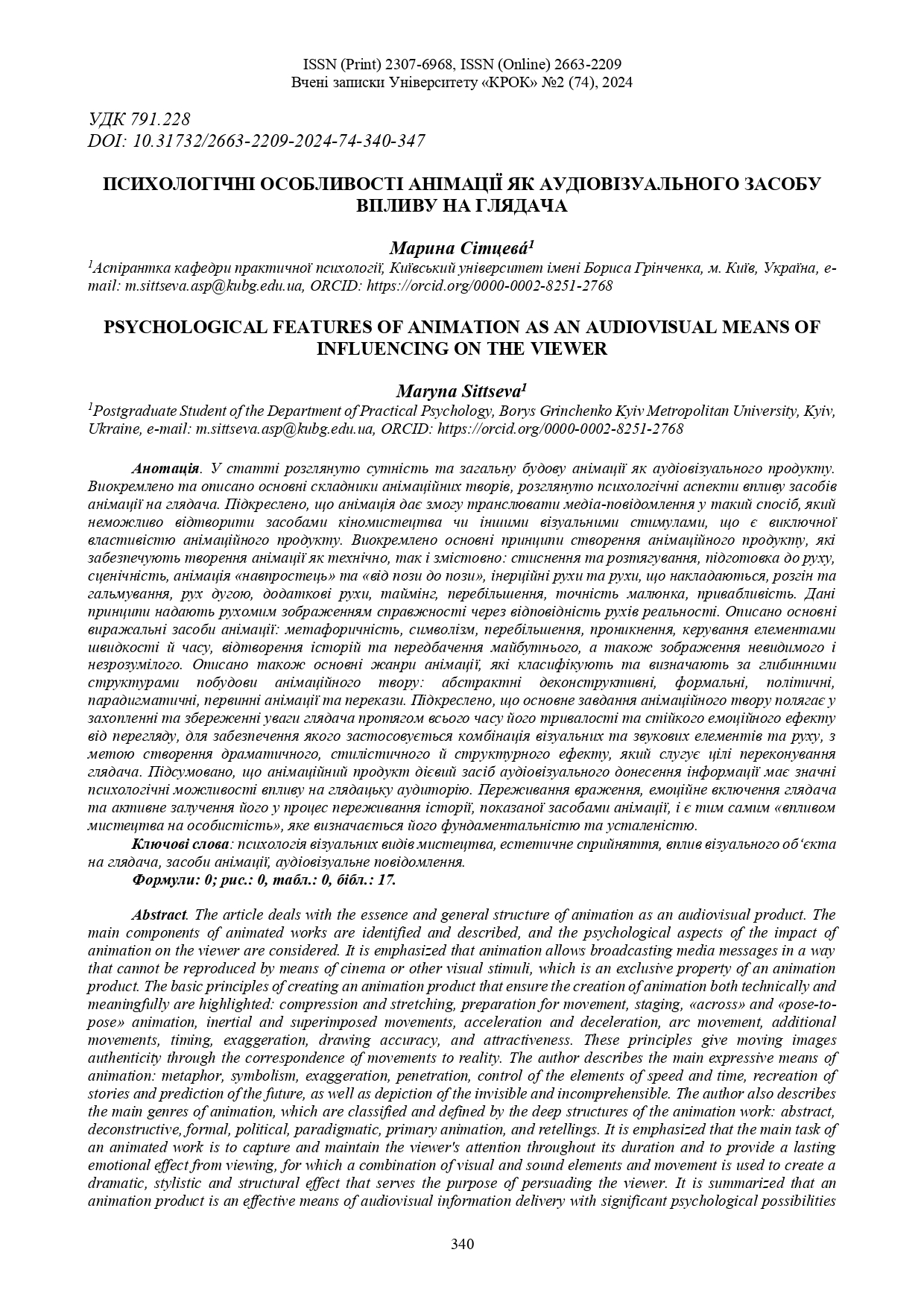PSYCHOLOGICAL FEATURES OF ANIMATION AS AN AUDIOVISUAL MEANS OF INFLUENCING ON THE VIEWER
DOI:
https://doi.org/10.31732/2663-2209-2024-74-353-360Keywords:
psychology of visual arts, aesthetic perception, influence of a visual object on the viewer, animation tools, audiovisual messageAbstract
The article deals with the essence and general structure of animation as an audiovisual product. The main components of animated works are identified and described, and the psychological aspects of the impact of animation on the viewer are considered. It is emphasized that animation allows broadcasting media messages in a way that cannot be reproduced by means of cinema or other visual stimuli, which is an exclusive property of an animation product. The basic principles of creating an animation product that ensure the creation of animation both technically and meaningfully are highlighted: compression and stretching, preparation for movement, staging, «across» and «pose-to-pose» animation, inertial and superimposed movements, acceleration and deceleration, arc movement, additional movements, timing, exaggeration, drawing accuracy, and attractiveness. These principles give moving images authenticity through the correspondence of movements to reality. The author describes the main expressive means of animation: metaphor, symbolism, exaggeration, penetration, control of the elements of speed and time, recreation of stories and prediction of the future, as well as depiction of the invisible and incomprehensible. The author also describes the main genres of animation, which are classified and defined by the deep structures of the animation work: abstract, deconstructive, formal, political, paradigmatic, primary animation, and retellings. It is emphasized that the main task of an animated work is to capture and maintain the viewer's attention throughout its duration and to provide a lasting emotional effect from viewing, for which a combination of visual and sound elements and movement is used to create a dramatic, stylistic and structural effect that serves the purpose of persuading the viewer. It is summarized that an animation product is an effective means of audiovisual information delivery with significant psychological possibilities of influencing the audience. The experience of the impression, the emotional involvement of the viewer and his/her active involvement in the process of experiencing the story shown by means of animation is the «influence of art on the personality», which is determined by its fundamental nature and stability.Downloads
References
Лозова О. (2022) Психосемантика смислових трансформацій у метафоричному мовленні. Монографія. Львів, СПОЛОМ, 2022. 134 с.
Петрунько О. (2010) Діти і медіа: соціалізація в агресивному медіа середовищі: Монографія. Полтава: Укрпромторгсервіс. 480 с.
Beck J. (2004) Animation Art. London: Flame Tree Publishing. 382 p.
Beckerman H. (2004) Animation: The Whole Story. New York: Allworth Press. 336 p.
Cholodenko A. (ed.) (1991) The Illusion of Life. Sydney: Power/AFC. 312 p.
Hahn D. (2008) The Alchemy of Animation: Making an Animated Film in the Modern Age. Los Angeles: Disney Editions. 144 p.
Laybourne K. (1998) The Animation Book. Three Rivers, MI: Three Rivers Press. 426 p.
Murphy M. (2008) Beginner’s Guide to Animation: Everything You Need to Know to Get Started in Animation. New York: Watson-Guptill. 128 p.
Pikkov Ü. (2010) Animasophy. Theoretical Writings on the Animated Film. Estonian Academy of Art. 200 p.
Pikkov Ü. (2018) Anti-Animation: Textures of Eastern European Animated Film. Estonian Academy of Arts. 264 p.
Selby A. (2009) Animation in Process. London: Laurence King. 191 p.
Taylor R. (1996) The Encyclopedia of Animation Techniques. Boston and Oxford: Focal Press. 176 p.
Wells P. & Hardstaff J. (2008) Re-Imagining Animation: The Changing Face of the Moving Image. Lausanne: AVA Publishing. 192 p.
Wells P. (2010) Understanding Animation. London and New York: Routledge. 265 p.

Downloads
Published
How to Cite
Issue
Section
License

This work is licensed under a Creative Commons Attribution-NonCommercial 4.0 International License.

